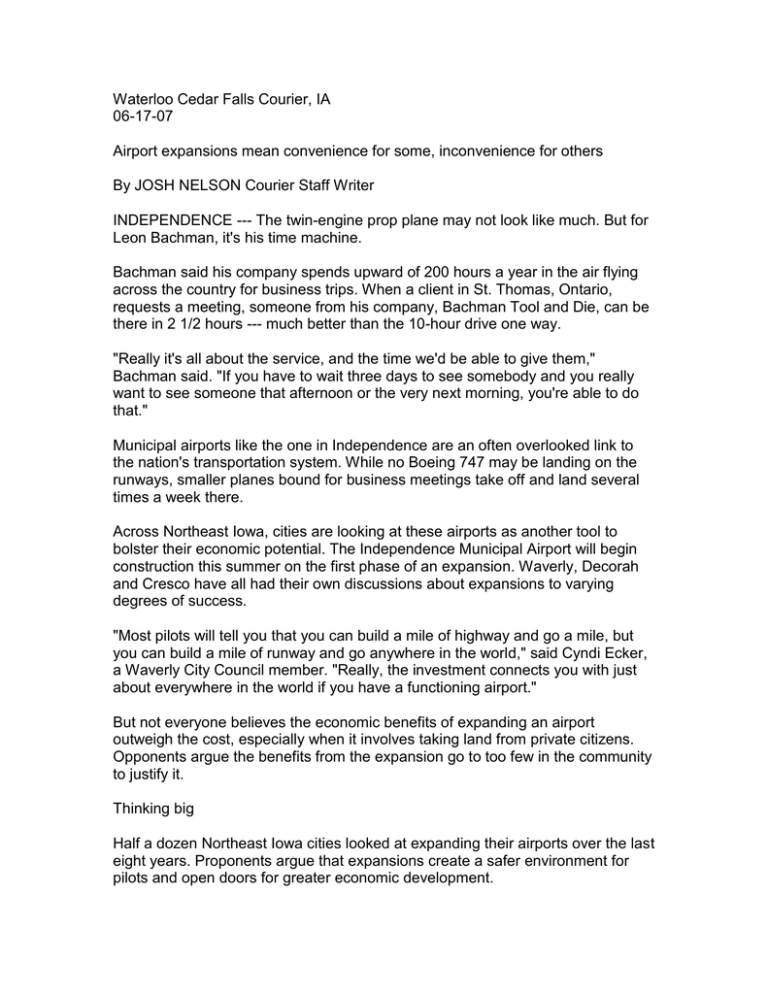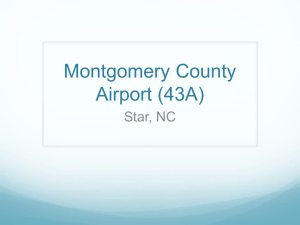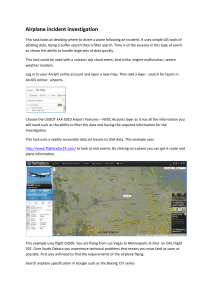Waterloo Cedar Falls Courier, IA 06-17-07
advertisement

Waterloo Cedar Falls Courier, IA 06-17-07 Airport expansions mean convenience for some, inconvenience for others By JOSH NELSON Courier Staff Writer INDEPENDENCE --- The twin-engine prop plane may not look like much. But for Leon Bachman, it's his time machine. Bachman said his company spends upward of 200 hours a year in the air flying across the country for business trips. When a client in St. Thomas, Ontario, requests a meeting, someone from his company, Bachman Tool and Die, can be there in 2 1/2 hours --- much better than the 10-hour drive one way. "Really it's all about the service, and the time we'd be able to give them," Bachman said. "If you have to wait three days to see somebody and you really want to see someone that afternoon or the very next morning, you're able to do that." Municipal airports like the one in Independence are an often overlooked link to the nation's transportation system. While no Boeing 747 may be landing on the runways, smaller planes bound for business meetings take off and land several times a week there. Across Northeast Iowa, cities are looking at these airports as another tool to bolster their economic potential. The Independence Municipal Airport will begin construction this summer on the first phase of an expansion. Waverly, Decorah and Cresco have all had their own discussions about expansions to varying degrees of success. "Most pilots will tell you that you can build a mile of highway and go a mile, but you can build a mile of runway and go anywhere in the world," said Cyndi Ecker, a Waverly City Council member. "Really, the investment connects you with just about everywhere in the world if you have a functioning airport." But not everyone believes the economic benefits of expanding an airport outweigh the cost, especially when it involves taking land from private citizens. Opponents argue the benefits from the expansion go to too few in the community to justify it. Thinking big Half a dozen Northeast Iowa cities looked at expanding their airports over the last eight years. Proponents argue that expansions create a safer environment for pilots and open doors for greater economic development. In 2004, the Iowa Department of Transportation put out a series of goals to develop the state's system of airports. The plan called for statewide expansion of local facilities by 2024. Many companies today rely heavily on air travel, so expanding that link will bolster local economies or bring new companies to the area, the report said. "It's just a fact that the way they're conducting business is with the use of business aviation," said Tim McClung, planning and outreach manager for the Iowa Department of Transportation's Office of Aviation. In Independence, a 1,500-foot runway expansion will allow jets to land at the airport. City officials expect that to make them a more appealing location for businesses. "Where airports many years ago were considered mainly just for leisure, that's no longer the case," Independence City Manager Alan Johnson said. "They're still part of an airport, ... but they're not the main factor of an airport anymore." The current runway is 4,000 feet long and 75 feet wide, a good size for municipal airports. Most prop engine airplanes can land there now. But if a jet wants to fly in, the plane's owner often has to waive insurance on the plane, and the pilot has to land with less than a full tank of fuel. The larger runway will cure those problems, Johnson said. "It really opens up another realm of air traffic," he said. In Iowa, only eight airports are designated as commercial facilities, capable of handling commercial passenger flights. Those are located in places like Cedar Rapids, Waterloo, Des Moines and Sioux City. Everything else is considered to be general aviation. Within that general aviation category, the airports themselves differ depending on their runway length, services and other features. Most want to be considered "enhanced." That was the designation Independence gained when it launched it expansion effort. It will allow Independence to jockey for more state and federal dollars to maintain the airport, Johnson said. Several businesses in the area besides Bachman rely on the facility to conduct business. The Wapsie Valley Creamery flies out from there about four times a year to meet clients around the Midwest, as far as Green Bay, Wis., or Kansas City, said Mark Nielsen, president of the creamery. "Most of our customers are five to eight hours away," Nielsen said. "It's not a real convenient drive." Both Nielsen and Bachman said they think the expansion will make the city a more attractive destination for business. "I figure maybe it'd help draw some larger businesses to town and better access for jets," Nielsen said. According to a 2000 Iowa State University economics study, general aviation airports produced about $170 million in total industrial output from companies based in Iowa in 1999. Approximately 1,274 jobs were maintained, according to the study. However, the airports included larger urban centers like the Quad Cities, Ames, Council Bluffs and Iowa City, which accounted for 60 percent of the air transportation services. McClung said expanding airports had a two-fold effect on economies: attracting new businesses and maintaining current companies. One such case is playing out in Pella. City officials are debating a proposal to build a regional airport outside of the city. The community's main employer, Pella Corp., said it needs a larger facility to operate its two jets, and the jets of its clients. A report from the city's airport commission recommended building a larger facility, but no specific targets were mentioned. The larger airport is so important to business, McClung said, that Pella could face losing its main employer if they don't build it. Despite state and federal support for increasing airport capacity, not everyone has gotten behind the push. Waverly and Decorah considered expanding their facilities with varying degrees of success. If you build it When talking about airports, one phrase often comes up: Bigger is better. Bigger runways mean bigger planes, bigger facilities and more services. "Anytime you have a longer runway, it's considered better from a pilot perspective," McClung said. But from the citizen's perspective, the expansion is often seen as a pet project that only affects a few companies. City officials may shy away from expansion projects if it involves exercising eminent domain to take land for the expansion. In Waverly, airport commissioners were sent back to the drawing board after an expansion plan was denied in December 2005 by the Waverly City Council. Council members were concerned that the plan called for taking some private property in the city to make room for the proposed expansion. Commissioners are now looking to build a bigger facility outside of the city limits, said Ecker, the City Council member. The runway at the Waverly Airport stands at 2,800 feet, shorter than safety recommendations from the Federal Aviation Administration of about 4,000 feet. City Engineer Mike Cherry said if the runway is expanded at its current location, the buffer zone around the airport would have to be increased. Ecker said commissioners are looking at sites that don't involve taking houses or land from private citizens. "To me, it would behoove Waverly --- the size of our community and as many of the wonderful assets that we have --- that we should have an airport that functions to serve the community both commercially and privately," Ecker said. Decorah ran into a similar problem when the city investigated an airport expansion. There wasn't enough area around the airport to expand, said City Administrator Jerry Freund. The city was briefly courted in 2004 by Cresco officials in a plan to develop a regional facility near Ridgeway, but there wasn't enough interest in Decorah for it, Freund said. The most striking aspect of the debate was the absence of the business community. The expected arguments that a longer runway would help attract more business weren't made during hearings on the proposal, he said. Afterward, Decorah considered extending its 4,000-foot runway, but that ran into more trouble. "The notion now of extending that runway is pretty much on hold, if not completely forgotten," he said. There are still some hurt feelings in Independence, where the city did use eminent domain for their expansion plans. Several landowners settled, but not before lengthy negotiations and a lawsuit. Most of the discussion involved taking farmland, but one family, the Hermsens, lost their 3-acre homestead they've lived on since 1991. Christine Hermsen said they received little warning last year that such an expansion was coming. There was just a little notice on the radio in February, she said. At first, they were assured the repairs wouldn't affect them, she said. "It just snowballed from losing horse pasture to actually losing our home," Hermsen said. "We got married, we bought that land and had three babies out there. That was my home. That was my forever home." The airport's clear zone stopped right near their house. FAA officials ruled that the zone was "pretty intrusive" on the house, and that the city should just buy the whole property. They received compensation, but she said it was hard to put a value on the home since they never intended to sell in the first place. The family eventually moved to another acreage near Jesup, but Hermsen said she is still skeptical that the expansion project was necessary. "This is a pet project," she said. "They saw grant money and went whole hog." Hermsen said she watched the airport during the eminent domain discussions, and didn't see enough air traffic to support their claims that it's needed. A lawsuit filed by the Crawford family, who owned land near the airport, echoed that sentiment. The family members argued there isn't adequate justification for the runway expansion. The suit said there wasn't enough operations to meet FAA requirements for expansions. The regulations require 500 annual itinerant operations, which can't include local flights shorter than 20 miles. The family dismissed the lawsuit May 3 after reaching a settlement for the land. Bet on black Even when the expansion project is said and done, there are still questions, city officials said. Most of the time, a firm can scout new locations without a city ever knowing. Site selection consultants can go online and find out about the facility or pick up information sheets from state and local economic development officials. If the site doesn't fit their needs, they'll move on. "It's not as much selection as it is elimination," Johnson said. Freund said he doesn't doubt that larger airports factor into the decision, but there are many other factors. The size of the work force or other pieces of vital infrastructure also may be important. He said the debate over airports kind of "begs the question" of if firms will relocate to the area. "It's a major gamble," Freund said. Ecker said another dimension to the debate is who is flying in. Local companies like Terex may not have their own planes, Ecker said, but their clients might. She also dismisses the idea that clients could fly in from the Waterloo Regional Airport. "I know people who are naysayers to the airport figure we should just hang out with the regional airport, but it's still 20 minutes in two directions," she said. For Bachman, the ease of being able to land his plane and then go home immediately is a major factor. If a client is flying in, he said they may not want to deal with the hassle of driving from Waterloo to Independence after landing. Johnson agrees. "It's not that they can't fly into Waterloo, Cedar Rapids or Dubuque. It's just then they have travel time, ground travel time," he said. "Convenience is the main thing in business."




